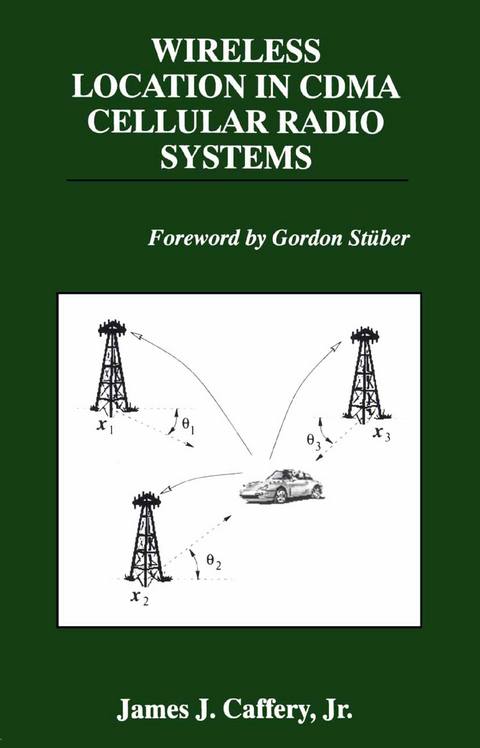
Wireless Location in CDMA Cellular Radio Systems
Seiten
1999
Springer (Verlag)
978-0-7923-7703-0 (ISBN)
Springer (Verlag)
978-0-7923-7703-0 (ISBN)
With the increasing market penetration of cellular telephones, the number of E-911 calls placed by cellular telephones has grown cons- erably. Phase II, to be completed by October 1, 2001, is much more stringent and requires that the location of an E-911 caller be determined and reported with an rms location accuracy of 125 m in 67% of the cases.
With the increasing market penetration of cellular telephones, the number of E-911 calls placed by cellular telephones has grown cons- erably. This growth in E-911 calls led to a 1996 FCC ruling requiring that all cellular, PCS, and SMR licensees provide location information for the support of E-911 safety services. The provision of such location information is to be implemented in two phases. Phase I, whose deadline has already been passed, requires that wireless carriers relay the caller’s telephone number along with location of the cell site and/or sector se- ing the call, to a designated Public Safety Answering Point (PSAP). This information allows the PSAP to return the call if disconnected. Phase II, to be completed by October 1, 2001, is much more stringent and requires that the location of an E-911 caller be determined and reported with an rms location accuracy of 125 m in 67% of the cases. The applications of wireless location technology extend well beyond E-911 services. Location information can be used by cellular telephone operators themselves for more effective management of their radio - sources, so as to achieve greater spectral efficiencies. Resource m- agement algorithms such as hand-offs between cell sites, channel assi- ments, and others can all benefit from subscriber location information. Location information obtained from vehicular based cellular telephones can be used as an input to Intelligent Transportation Systems (ITS), and in particular traffic management and traveler information systems.
With the increasing market penetration of cellular telephones, the number of E-911 calls placed by cellular telephones has grown cons- erably. This growth in E-911 calls led to a 1996 FCC ruling requiring that all cellular, PCS, and SMR licensees provide location information for the support of E-911 safety services. The provision of such location information is to be implemented in two phases. Phase I, whose deadline has already been passed, requires that wireless carriers relay the caller’s telephone number along with location of the cell site and/or sector se- ing the call, to a designated Public Safety Answering Point (PSAP). This information allows the PSAP to return the call if disconnected. Phase II, to be completed by October 1, 2001, is much more stringent and requires that the location of an E-911 caller be determined and reported with an rms location accuracy of 125 m in 67% of the cases. The applications of wireless location technology extend well beyond E-911 services. Location information can be used by cellular telephone operators themselves for more effective management of their radio - sources, so as to achieve greater spectral efficiencies. Resource m- agement algorithms such as hand-offs between cell sites, channel assi- ments, and others can all benefit from subscriber location information. Location information obtained from vehicular based cellular telephones can be used as an input to Intelligent Transportation Systems (ITS), and in particular traffic management and traveler information systems.
System and Channel Models.- Location Methods and Impairments.- Algorithms for Radiolocation.- Performance of Location in CDMA Systems.- To A Estimation in Multiple-Access Interference.- Analysis and Mitigation of NLoS Effects.- Provisions for Location in Wireless Standards.- Conclusions & Future Directions.
| Reihe/Serie | The Springer International Series in Engineering and Computer Science ; 535 |
|---|---|
| Zusatzinfo | XVI, 189 p. |
| Verlagsort | Dordrecht |
| Sprache | englisch |
| Maße | 156 x 234 mm |
| Themenwelt | Mathematik / Informatik ► Informatik ► Netzwerke |
| Technik ► Elektrotechnik / Energietechnik | |
| Technik ► Nachrichtentechnik | |
| ISBN-10 | 0-7923-7703-6 / 0792377036 |
| ISBN-13 | 978-0-7923-7703-0 / 9780792377030 |
| Zustand | Neuware |
| Haben Sie eine Frage zum Produkt? |
Mehr entdecken
aus dem Bereich
aus dem Bereich
das umfassende Handbuch für den Einstieg in die Netzwerktechnik
Buch | Hardcover (2023)
Rheinwerk (Verlag)
CHF 41,85
von den Grundlagen zur Funktion und Anwendung
Buch (2023)
Carl Hanser (Verlag)
CHF 41,95


